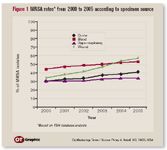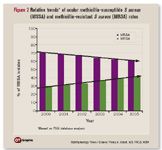Article
Increasing prevalence of ocular MRSA noted
The rate of methicillin-resistant Staphylococcus aureus (MRSA) is increasing in both systemic and ocular infections, according to an analysis of nationwide surveillance data. Increasing rates of resistance and lowered rates of susceptibility could soon reduce the number of drugs that can be successfully used to treat ocular infections.

Among S aureus isolates from a variety of clinical specimens, MRSA prevalence has increased from 29.5% in 2000 to 41.6% in 2005, and a 12.1% increase in MRSA among S aureus isolates from ocular sources was seen during the same period, Dr. Asbell said. She and colleagues from an independent laboratory analyzed nationwide surveillance data and summarized their findings in a poster at the American Academy of Ophthalmology meeting in November.
The data, collected from several hundred institutions over a 5-year period, showed an increasing level of resistance, with the percentage of MRSA potentially surpassing that of methicillin-susceptible S aureus (MSSA) by 2008, Dr. Asbell said, adding that this trend will have implications in the ophthalmology community as well as in medicine as a whole.
Antimicrobial susceptibility
The study also analyzed the antimicrobial susceptibility of ocular S aureus based on methicillin status from 2004 to September 2006. For every agent except trimethoprim, MRSA susceptibility is substantially lower than MSSA susceptibility. The agents tested included ciprofloxacin (Ciloxan, Alcon Laboratories), gatifloxacin (Zymar, Allergan), levofloxacin (Quixin, Vistakon), penicillin, polymyxin B, tobramycin (Tobrex, Alcon), and trimethoprim.


Newsletter
Don’t miss out—get Ophthalmology Times updates on the latest clinical advancements and expert interviews, straight to your inbox.




